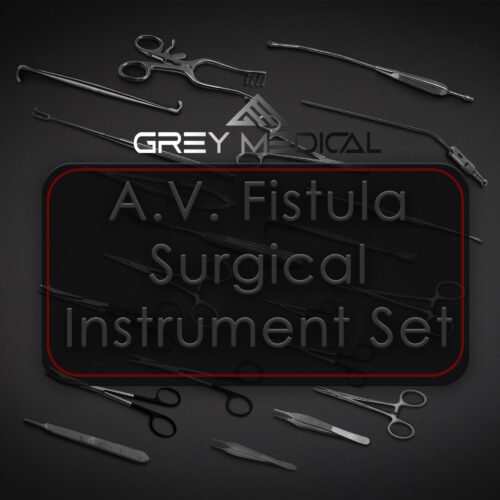Surgical Instrument Sets: Comprehensive Kits for Specific Procedures
Surgical Instrument Sets: Comprehensive Kits for Specific Procedures
Blog Article
A
surgical instrument set is a collection of tools carefully assembled to meet the requirements of specific surgical procedures. These
surgical instrument sets include a variety of instruments designed to perform tasks such as cutting, dissecting, grasping, holding, retracting, and suturing tissues during surgery. Surgical instrument sets are tailored to different medical specialties and procedures, ensuring that surgeons have the right tools for optimal outcomes.

Types of Surgical Instrument Sets
- General Surgery Instrument Set:
- Includes versatile tools suitable for a wide range of surgical procedures.
- Common instruments: scalpel handles and blades, surgical scissors (Mayo, Metzenbaum), needle holders, forceps (tissue and dressing), retractors, and hemostatic clamps (such as mosquito, Kelly, or Crile clamps).
- Orthopedic Surgery Instrument Set:
- Designed for bone-related procedures such as fracture repair, joint replacement, and osteotomies.
- Common instruments: bone saws, osteotomes, bone rongeurs, periosteal elevators, bone clamps, and screwdrivers for implants.
- ENT Surgery Instrument Set:
- Used for ear, nose, and throat procedures.
- Common instruments: Freer septum knife, nasal speculums, sinus forceps (e.g., Blakesley), ear hooks, and micro-scissors.
- Cardiovascular and Thoracic Surgery Set:
- Contains instruments for delicate procedures involving the heart, lungs, and blood vessels.
- Common instruments: Potts scissors, vascular clamps, rib spreaders, needle holders, and fine-tipped forceps.
- Gynecology and Obstetrics Instrument Set:
- Tailored for procedures like cesarean sections, hysterectomies, and vaginal repairs.
- Common instruments: uterine dilators, curettes, vaginal speculums, hemostatic forceps, and scissors.
- Plastic Surgery Instrument Set:
- Focused on precision for aesthetic and reconstructive surgeries.
- Common instruments: fine forceps, microsurgical scissors, skin hooks, needle holders, and delicate retractors.
- Dental Surgery Instrument Set:
- Includes tools for tooth extractions, root canals, and implantology.
- Common instruments: extraction forceps, elevators, bone files, periosteal elevators, and dental mirrors.
- Laparoscopic Instrument Set:
- Designed for minimally invasive surgeries.
- Common instruments: laparoscopic scissors, graspers, dissectors, trocars, and cannulas.
- Microsurgery Instrument Set:
- For highly detailed procedures under a microscope, such as neurosurgery or ophthalmic surgery.
- Common instruments: micro scissors, micro forceps, fine needle holders, and speculums.
Key Instruments Found in Surgical Sets
- Cutting and Dissecting Instruments:
- Scalpel, scissors (Mayo, Metzenbaum, tenotomy), osteotomes, and rongeurs.
- Grasping and Holding Instruments:
- Tissue forceps (Adson, DeBakey), allis forceps, and needle holders.
- Retracting Instruments:
- Hand-held retractors (Richardson, Army-Navy) and self-retaining retractors (Weitlaner, Balfour).
- Hemostatic Instruments:
- Clamps and forceps (mosquito, Kelly, Crile) for controlling bleeding.
- Suturing and Stapling Instruments:
- Needle holders, suture scissors, and staplers.
- Diagnostic Instruments:
- Probes, sounds, and measuring tools like calipers or rulers.
Customization and Specialized Sets
Surgical instrument sets can be customized to meet the specific needs of a procedure or surgeon preference. Many manufacturers offer sets tailored for particular specialties or even individual procedures. Customization may include selecting specific materials (e.g., titanium for lightweight instruments), adding coatings (e.g., non-reflective finishes), or including specialized tools for unique surgical challenges.
Care and Maintenance
Proper care and maintenance of surgical instrument sets are critical to ensure their longevity and performance. After each procedure, instruments should be cleaned, inspected for damage, and sterilized. Special attention should be given to delicate instruments, such as scissors and forceps, to prevent dulling or misalignment. Routine maintenance, including sharpening and repair, ensures that the instruments remain reliable and safe for use.
Conclusion
Surgical instrument sets are vital components of any operating room, providing surgeons with the tools they need to perform procedures effectively and efficiently. Whether for general surgery or highly specialized fields, these sets are carefully designed to meet the demands of modern medical practice. Proper assembly, care, and maintenance of surgical instrument sets contribute significantly to successful surgical outcomes and patient safety.
Report this page
